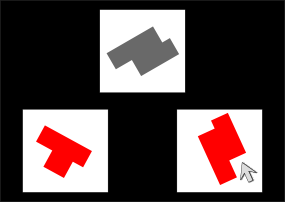Introduction
Mental rotation is imagining what a stimulus would look like if it would be rotated.
Mental rotation tasks are difficult. In these tasks, you might see three stimuli like in the example figure. The top one is the one that matches only one shown at the bottom. But the matching stimulus is rotated. The participant has to mentally rotate (i.e., imagine what something looks like when it is rotated) one or both stimuli (people can figure out their own strategy, there are multiple strategies possible).
Mental rotation time is defined as the time it takes someone to find out if a stimulus matches another stimulus through mental rotation. It is a well established fact that men and women perform differently on this task.
In this demonstration, we are going to rotate 2 dimensional (2D) stimuli. 2D stimuli are those without depth. Rotating stimuli with depth (3D) is more difficult than rotating 2D stimuli.
Advertisement
Please note that the ad below is to support the PsyToolit platform. Clicking it helps us.
Above is an add. The rest below is ad free. Thank you for watching this.
About this implementation

In the above screen shot, you see three two-dimensional stimuli. For this demo, we use 2D stimuli (in part because they are easier to create).
| If you wish, you can get 3D datasets online. |
The grey stimulus at the top is the one you need to match with one of the red ones. In order to match the grey stimulus, you need to imagine what it looks like when it is rotated. In this example, the right one matches, and thus needs to be clicked (as indicated by the little grey mouse cursor).
In the following demonstration, you will need to find out which two object match each other. You can only do that if you mentally rotate the objects and see which ones match. In this example, the stimuli are 2 dimensional, or 2D. In psychology, the most common mental rotation experiments have stimuli with depth, that is 3D.
-
Note, you can show your response times and copy and paste them to a local file for your own data analysis.
Run the demo
Data output file
| In PsyToolkit, the data output file is simply a textfile. The save line of the PsyToolkit experiment script determines what is being saved in the data output file. Typically, for each experimental trial, you would have exactly one line in your text file, and each number/word on that line gives you the information you need for your data analysis, such as the condition, response speed, and whether an error was made. |
Meaning of the columns in the output datafile. You need this information for your data analysis.
| Colum | Meaning |
|---|---|
1 |
blockname |
2 |
table row number (that way you can look up exactly which stimulus was presented) |
3 |
location of the correct image (0=left,1=right) |
4 |
the response time (ms) |
5 |
status (1=correct, 2=error, 3=too slow) |
Check out the source code
Download
| If you have a PsyToolkit account, you can upload the zipfile directly to your PsyToolkit account. |
If you want to upload the zipfile into your PsyToolkit account, make sure the file is not automatically uncompressed (some browsers, especially Mac Safari, by default uncompress zip files). Read here how to easily deal with this.
Further reading
Shephard, R.N. and Metzler, J. (1971). Mental Rotation of Three-Dimensional Objects. Science, 171, 701-703.
Collins, D.W. and Kimura, D. (1997). A Large Sex Difference on a Two-Dimensional Mental Rotation Task. Behavioral Neuroscience, 111, 845-849.
